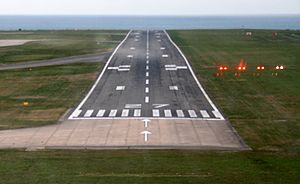Precision approach path indicator facts for kids
A Precision Approach Path Indicator (PAPI) is a special system of lights at an airport. These lights are placed next to the runway where planes land. They help pilots see if their plane is coming down at the correct angle to land safely. Think of it like a visual guide for planes as they get ready to touch down. Usually, PAPI lights are on the left side of the runway, about 300 meters (about 984 feet) from where planes first land.
Contents
How PAPI Lights Work
PAPI lights are designed to show pilots if they are too high, too low, or just right for landing. Each PAPI system has a row of four special light units.
Inside a PAPI Light Unit
Each PAPI light unit is built to create a very bright beam of light.
- It has two light bulbs, so if one stops working, the other can still shine.
- There are special mirrors inside.
- A red filter helps create the red light.
- Lenses shape the light beam.
The amazing thing about these lights is how they change color. The bottom part of the light beam is red, and the top part is white. The change from red to white happens very quickly, over a tiny angle. This makes it easy for pilots to see the color change clearly.
Understanding the Colors
The four PAPI units are set up so their color changes happen at slightly different angles.
- If you see four white lights, you are too high.
- If you see three white lights and one red light, you are a little high.
- If you see two white lights and two red lights, you are on the perfect path to land. This is called the "glideslope."
- If you see one white light and three red lights, you are a little low.
- If you see four red lights, you are too low.
This system helps pilots adjust their plane's height to land smoothly and safely.
Where PAPI Lights are Placed
PAPI lights are usually placed on the left side of the runway, in a straight line. They are about 15 meters (about 49 feet) from the edge of the runway. Each light unit is about 9 meters (about 30 feet) apart from the next.
Sometimes, if needed, PAPI lights can be on the right side of the runway. No matter which side they are on, the red lights are always closer to the runway itself. Some airports even have PAPI lights on both sides of the runway for extra guidance!
The exact distance from the runway start (threshold) depends on the types of planes that use the airport. It also considers how well the PAPI works with other landing systems, like the Instrument Landing System (ILS).
History of PAPI Lights
The PAPI system was first created in 1974 by two clever people, Tony Smith and David Johnson. They worked at the Royal Aircraft Establishment in Bedford, England. It took them two more years to fully develop this amazing technology. The same design they created is still used today!
Their work was highly praised and they received many awards for making flying safer.
PAPI lights were even used by NASA's Space Shuttle to help it land safely!
Before PAPI, there was an older system called VASI (Visual Approach Slope Indicator). VASI only helped pilots until they were about 60 meters (about 200 feet) above the ground. PAPI is better because it guides pilots much closer to the runway, down to about 15 meters (about 50 feet) before they start the final part of their landing.
Modern PAPI Lights
Around 2008, new PAPI lights started using LED bulbs instead of older types. LEDs are much brighter, last a very long time (50,000 hours or more!), and use much less electricity. Because they use so little power, some PAPI systems can even run on solar power, making them work without needing to be connected to the main power grid.
PAPI and Runway Safety
PAPI lights are also used in a new safety system called FAROS (Final Approach Runway Occupancy Signal). This system is being used at some big airports in the United States.
Here's how FAROS works:
- Sensors on the runway detect if a vehicle or another plane is on the runway when it shouldn't be.
- If there's something on the runway, the PAPI lights will flash to warn the pilot who is about to land.
- The pilot then knows the runway is not clear and can tell air traffic control. They will then fly around and try to land again later (this is called a "go-around").
- Once the runway is clear, the air traffic controller turns the PAPI lights back to normal, and planes can land again.
This system helps prevent accidents by giving pilots a direct visual warning if the runway is not safe to land on.
See also
 In Spanish: Indicador de Trayectoria de Aproximación de Precisión para niños
In Spanish: Indicador de Trayectoria de Aproximación de Precisión para niños
- Approach lighting system (ALS)
- Pilot controlled lighting (PCL)
- Visual approach slope indicator (VASI)
- Instrument landing system (ILS)
- Runway end identifier lights (REIL)
- Runway edge lights (HIRL, MIRL, LIRL)
- Optical landing system
- Leading lights



